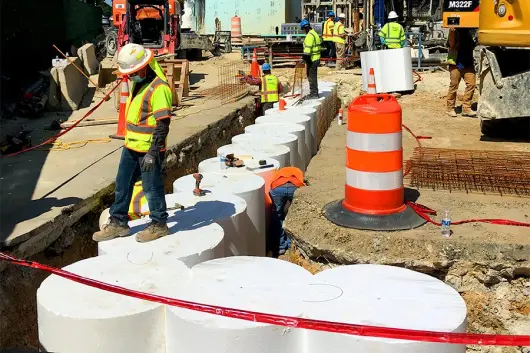Secant Pile walls are constructed using deep, overlapping concrete cylinders that are reinforced with rebar cages or steel I-beams. This method creates a robust foundation or wall system while minimizing disturbance to the surrounding area and preventing damage to nearby property lines.
Poly Molding’s EPS secant forms streamline the process and reduce the cost of laying out and drilling secant walls. Depending on the required cylinder size, forms are often supplied in groups of 2, 3, or more overlapping cylinders per form. These EPS guide forms can be made to any diameter and depth needed. They can be drilled out after the concrete guides are completed, or if environmental concerns arise, they can be removed before drilling.
They are also used in dam and subway construction as well as certain marine applications. Poly Molding’s secant forms are available from various locations across the United States and Canada.

As time progresses, construction businesses, architects, and engineers are gravitating toward geofoam as it is easy to work with, affordable, and requires a minimal time investment. In fact, it merely takes a couple of workers to move a large block of geofoam by hand. This is much more efficient than investing the time and effort necessary to fill the area with soil. In fact, the use of geofoam for roadbed or embankment support prevents the need for heavy construction.
Geofoam is also favored as there is minimal disturbance to the land along the exterior of the foundation. Geofoam is water-resistant, easy to put into perfect position and built to last. Secant pile wall construction with geofoam will be used in more and more civil engineering projects with embedded retaining walls. Geofoam facilities the stabilization of embankments basements and other storage spaces.
Furthermore, geofoam helps create secant walls that stabilize and protect subterranean tanks as well as other buried structures. As long as the groundwater table location, deflections, propping, soil conditions and other factors are reviewed appropriately beforehand, geofoam will prove optimal for secant wall construction.